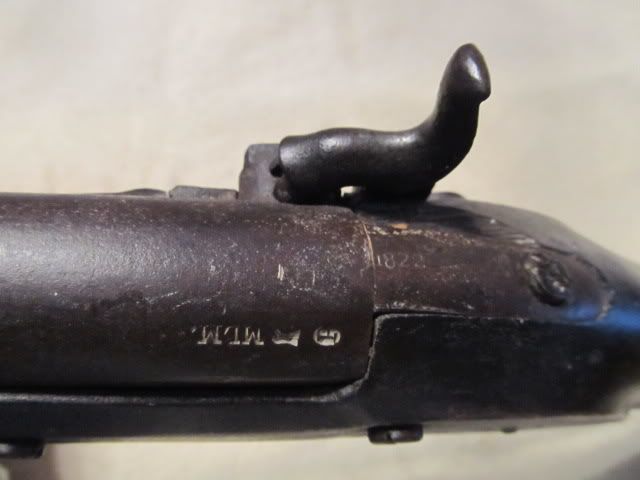http://i1127.photobucket.com/albums/l639/bottlebob62/g1-1.jpg
-------------------------------------------------------------------------------- http://i1127.photobucket.com/albums/l639/bottlebob62/bb4.jpg
http://s1127.photobucket.com/albums/l639/bottlebob62/bb1.jpg"
I am attempting to ID the type of musket this is for a local museum display. It was carried by William Byrn of the 2nd Mississippi Inf CSA. It is in rough condition after being in a old building for the last 100 or so years. I was told by a local collector of CW that it is a flintlock conversion musket. I have it taken apart now so it can be cleaned somewhat and have found some markings that might help id it to a person who knows antique firearms. On the underside of the barrel near the breechplug it has stamped into the barrel a "XI-" or thats what it looks like to me. Also the side plate has something on it but I cannot make it out it kinda looks like a "Sb and maybe something else" THE hammer has a 55 stamped into the rear of it and I can make out a letter B on the backupper part of the sideplate. There is a letter L stamped into the wood part of the stock where the barrel covers it. The one surviving barrel band has a letter "D " on it with " * " The barrel is 43" from the end of the breechplug to the end of the barrel or minus the breechplug it is a little less than 40 1/4" . It still has the bayonet lug on the barrel so the barrel has not been cut off just the forewood under it. I have a lot of info on the man who carried it he was a Roll of Honor member of the 2ND Miss
He carved his name into one side of the stock of the gun and there is a MS and a large l on the other He was in company B and L . I know the gun as far as gun wise would have little value but as a Id'ed CSA carried weapon it has historical value . I can see where he cut the forewood off under the barrel and that will have to be replaced as well as some other small parts but until we can ID the stype of weapon we are at a standstill. Thank you for any help with this piece . Bob
-------------------------------------------------------------------------------- http://i1127.photobucket.com/albums/l639/bottlebob62/bb4.jpg
http://s1127.photobucket.com/albums/l639/bottlebob62/bb1.jpg"
I am attempting to ID the type of musket this is for a local museum display. It was carried by William Byrn of the 2nd Mississippi Inf CSA. It is in rough condition after being in a old building for the last 100 or so years. I was told by a local collector of CW that it is a flintlock conversion musket. I have it taken apart now so it can be cleaned somewhat and have found some markings that might help id it to a person who knows antique firearms. On the underside of the barrel near the breechplug it has stamped into the barrel a "XI-" or thats what it looks like to me. Also the side plate has something on it but I cannot make it out it kinda looks like a "Sb and maybe something else" THE hammer has a 55 stamped into the rear of it and I can make out a letter B on the backupper part of the sideplate. There is a letter L stamped into the wood part of the stock where the barrel covers it. The one surviving barrel band has a letter "D " on it with " * " The barrel is 43" from the end of the breechplug to the end of the barrel or minus the breechplug it is a little less than 40 1/4" . It still has the bayonet lug on the barrel so the barrel has not been cut off just the forewood under it. I have a lot of info on the man who carried it he was a Roll of Honor member of the 2ND Miss
He carved his name into one side of the stock of the gun and there is a MS and a large l on the other He was in company B and L . I know the gun as far as gun wise would have little value but as a Id'ed CSA carried weapon it has historical value . I can see where he cut the forewood off under the barrel and that will have to be replaced as well as some other small parts but until we can ID the stype of weapon we are at a standstill. Thank you for any help with this piece . Bob
Last edited by a moderator:







